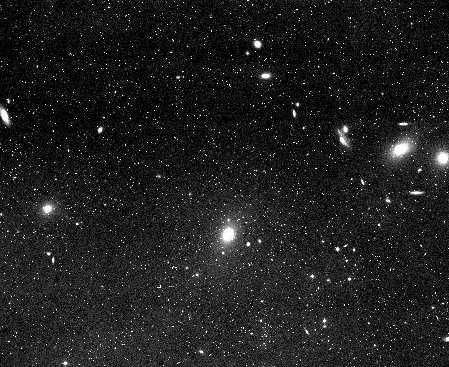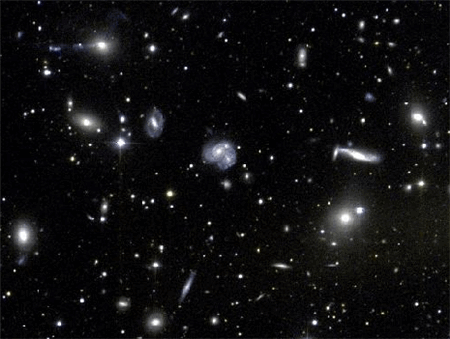Galaxies are never found alone. They are all a part
of a local group which is then a part of a cluster
of
galaxies. The role of Dark Matter plays a vital
role in the distribution of galaxy clusters, but
that is covered later.Clusters do have some
categories:
- Regular clusters
- Irregular clusters
Each category have two sub-categories:
- Rich clusters - clusters that contain 50 or
more galaxies
- Poor clusters - clusters that contain less
than 50 galaxies
Galaxy clusters are classified based on a system
proposed by astronomy George Abell and are
documented in the Abell Catalog.
Regular clusters are large and symmetrical that
have a diameter between 1 and 10 Mpc. The rich and
poor categories are defined by the number of
galaxies located within 1.5 Mpc from the center of
the cluster. This is called the Abell radius.
A regular cluster has at its center the brightest
member, and is typically a large elliptical galaxy.
This is called the Brightest Cluster Galaxy, or BCG.

The Coma cluster - Abell 1656 (above image) - is
an example of a rich regular cluster. Here the
center of the cluster is shared between the two
bright elliptical
galaxies (the two bright objects
at the center of the image).
This cluster is 7Mpc in diameter and is thought
to contain almost 2000
galaxies. The bright object
in the upper right is a star from our own galaxy.
Irregular clusters can also have a prominent BCG
(and can sometimes be a giant elliptical galaxy) but
are more disorganized in appearance. There is also
no centralized concentration of
galaxies near the
center of the cluster.

The Virgo cluster (above image) is hosted by the
elliptical galaxy M87. but notice the field is not
rich on galaxies, and there is no even galaxy
distribution.
Galaxy clusters can be young as well. The image
below is of the Hercules cluster.

The lack of elliptical galaxies indicates this
cluster is young. Even though there is no BCG, this
is still considered a regular cluster - notice the
even distribution of galaxies.
Back to Top |

